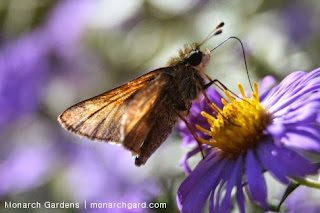Stop with the honey bees. Every day I come across a half dozen new articles
on the plight of the European honey bee. It's become sheer agony for me.
Frankly, even though neonics and modern farming techniques play a key role in
honey bee loss (among many other life forms), I think the attention the news
media and everyday folks subsequently place on honey bees does nothing but
bolster modern agriculture; and what I mean by that is the image of a bee shifts
the mental image away from sprays and rows of corn to something different, more
human and feeling. I especially love the irony of
Bayer's Bee Care Center.
Of course the focus on honey bees also takes us away native bees and other
pollinators. When it takes 60% of ALL U.S. honey bee colonies to pollinate just
the almond crop in California (some 80% of global almonds come from CA), we
create one dangerous monoculture supporting another. The Xerces Society has recently
begun planting native plant hedgerows in 1,000 acres of almond farms in California, as
well as pollinator ground cover among the trees, as a way to increase
pollination success, mitigate pesticides, and lesson the need for water.

Native bees are vanishing as fast as honey bees, maybe faster. Many require
native plants -- plenty of species forage on only one species (oligolectic
bees), let's take aster, gathering pollen and nectar for winter larvae to eat
before they emerge as adult bees the next spring and summer. Native bees
collectively have a pollination efficiency rate of 91%, compared to honey bees
at 71%. Tomatoes can only be pollinated by native bees, and crops like squash,
blueberries, and alfalfa are better pollinated by native bee species evolved
for the job. It's been shown that strawberries are more uniform in shape and
have a longer shelf life -- making them appealing to consumers and grocery
stores -- if a diversity of bees pollinate them. Honey bees are more inclined
to visit generalist flowers, those more often visited by a wide range of
pollinators, which reduce seed yield and genetic diversity of other plants. Often, when you take just one bee species out of the foraging equation, total pollination rates fall.
75-90% of native bee species are also solitary, nesting in the ground or in
holes found in trees, for example (which makes farm hedgerows a necessity).
That solitary nesting leads to more benign bees -- they don't have that
"protect the hive mentality" that gives all bees -- maybe most flying
insects -- a bad rap and a high fear factor. I once did a garden consult where
the client asked that I keep away any flowers that might attract bees from the
front porch or sidewalk, which is a lot like asking me to stay out of the candy
drawer.
With 4,000 native species who have and still could pollinate more
effectively than honey bees, I'd like to see more articles written on providing
native bee habitat. Let's start talking about
prairie
STRIPs. Let's look at New Mexico, who's been
planting 7,500 miles of road edges with native forbs and
grasses -- increasing pollinator habitat and significantly reducing the amount
of carbon pollution caused by passing motorists (not to mention maintenance
bills from mowing too often). Let's get to the root of sustainability and the
trillions of dollars worth of free global pollinator services that happen each
year -- more habitat with native plants, starting in our gardens, parks, city
grounds, highway edges, and farm margins.















.JPG)


